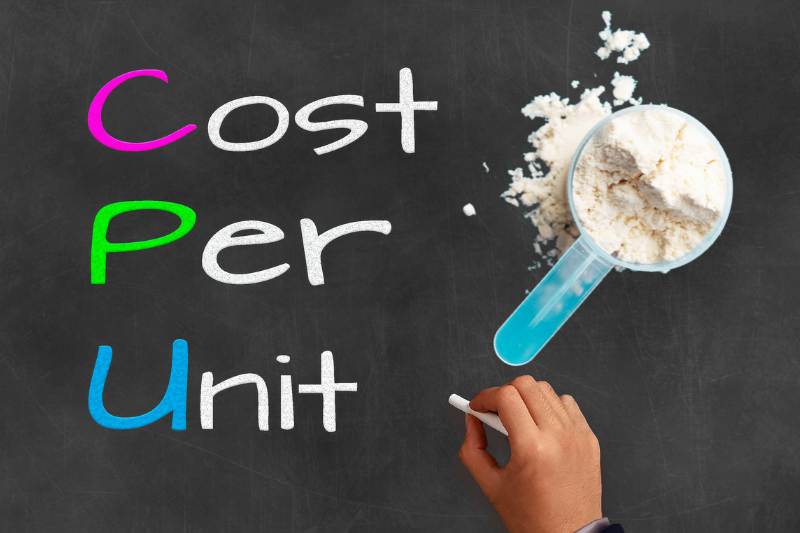Buying a protein powder on price alone can be confusing (or just a blatant rip-off) due to differences in container sizes, serving sizes, and the percentage of protein in the product (relative to other ingredients like carbohydrate and fat). That’s why I created this simple and free protein powder best value per unit comparison calculator.
Price alone doesn’t tell the whole story (i.e., cheaper in price might actually be more expensive in the long run). A cheap container of whey protein might seem like a great deal, but if it has a lower protein percentage or a larger scoop size with less protein per serving, then you’re probably not getting the best value for money.
Instead of guessing which protein powder is the best deal, this calculator takes away the guesswork and helps you compare price per gram, scoop, serving, or kilogram to ensure you get the most protein bang for your buck.
After you’re done, check out my other calculators on this site including my macro percentage calculator, meat protein calculator, lean body mass calculator, and net carbs calculator.
Protein Powder Best Value Calculator
How a protein powder can help you reach your goals
If you’re a hard-training athlete and having a difficult time meeting your protein targets with food alone, a protein powder is convenient way to help you meet your nutritional needs for muscle growth, recovery, and overall health (without the hassle of cooking and preparing extra high-protein meals).
What’s the best protein powder?
There are several types of protein powders available, each catering to different dietary preferences and fitness goals.
- Whey protein is one of the most popular options due to its high bioavailability, fast absorption, and high-quality amino acid profile, making it ideal for post-workout recovery.
- Casein protein digests more slowly, providing a steady release of amino acids, which can be beneficial before bedtime.
- Plant-based protein options such as pea, rice, or soy protein can offer a great alternative without compromising protein intake.
While finding a cost-effective protein powder is important, don’t let price alone be the only deciding factor. A cheaper protein powder might contain fillers, lower protein content per serving, or poor-quality ingredients.
Bottom line: use this calculator to compare options and strike a balance between affordability and quality.
How to compare protein powders for the best value

To get the best protein powder bang for money, consider the following factors when making a protein powder price comparison:
Protein content per unit / serving
Pay attention to how much actual protein you’re getting per serving. Some brands may have large serving or scoop sizes but contain less protein per unit (i.e., per gram, scoop, serving, kg, oz, per 100g). But the problem with this is that you’ll run out of product faster. Focusing on price per gram of protein powder per serving ensures you’re not paying for unnecessary fillers.
Additives & fillers
Some cheaper protein powders contain extra carbs, fats, or artificial fillers that dilute the protein content. While these might not be harmful, they can reduce the overall value of the product. Always check the ingredient list to ensure you’re paying for quality protein, not unnecessary product bloat.
Best value buying strategies
While price per gram is important, here are some other tips to maximise value without cutting quality:
- Buy in bulk – Larger tubs often offer a lower price per gram or per 100g, making them a more cost-effective choice in the long run. Just be sure to check the expiration date, especially if you don’t go through protein powder quickly.
- Buy online – reputable online retailers with excellent reviews and brand name products may be able to offer better prices on the same products you’d buy at a brick and mortar retailer due to lower overheads.
- Look for sales and discounts – Many retailers offer periodic discounts, bundle deals, or loyalty rewards. Signing up for email alerts or keeping an eye on seasonal sales can help you grab your favorite protein powder at a lower cost.
- Compare different brands – Well-known brands charge a premium for their name, but lesser-known brands may provide the same quality at a better price. Checking the protein content per serving and ingredient list can help you find hidden gems.
- Read independent reviews – A low price doesn’t always mean a good deal. Before committing to a purchase, check customer reviews and third-party lab tests to ensure the protein powder delivers on quality and purity.
- Shipping costs – if buying online, factor in shipping costs (as is used in this calculator) to see if this significantly alters the price per unit.
Take home message
Bottom line: not all protein powders are the same. Use this protein powder best value comparison calculator to cut through the bullsh*t and marketing hype and go straight to the best quality protein powder at the best price per unit (i.e., price per gram, oz, 100g, or per lb / kg). And if you found it helpful, be sure to share with your friends!

